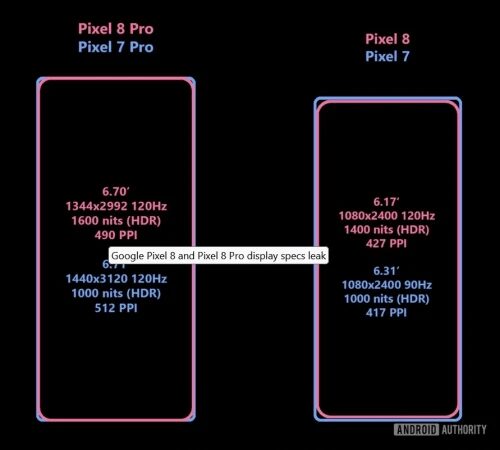An insider at Google has recently divulged exclusive information to Android Authority regarding the highly anticipated Pixel 8 and Pixel 8 Pro smartphones. While some of the leaked details corroborate previous reports from the reputable tipster Ross Young at Display Supply Chain Consultants (DSCC), there are intriguing revelations about the display features of these 2023 flagship devices.
This article will delve into the specifics, starting with the Pixel 8 and subsequently exploring the more advanced Pixel 8 Pro.
Contents
Pixel 8 Display Upgrades
As per Young’s earlier disclosures, Google is downsizing the Pixel 8’s display from the 6.31-inch panel featured on the Pixel 7 to a more compact 6.17 inches. The resolution remains at 1080 x 2400 FHD+, but the refresh rate receives a boost from 90 Hz to 120 Hz.
Additionally, the brightness with HDR content sees an improvement from a peak of 1000 nits to 1400 nits. Surprisingly, the smaller display results in a higher pixel density, rising from 417 to 427 pixels per inch (PPI).
Revamped Pixel 8 Pro Display
Significant changes are in store for the Pixel 8 Pro’s screen. The curved display, previously divisive among users of the Pixel 6 Pro and Pixel 7 Pro, is replaced by a flat display on the Pixel 8 Pro. Google has taken into account the preferences of its users, favoring a more traditional flat screen design.
Similar to the Pixel 8, the Pixel 8 Pro experiences a slight reduction in display size, transitioning from 6.71 inches to 6.70 inches. The most surprising alteration pertains to the drop in resolution, with the Pixel 8 Pro featuring a 1334 x 2992 resolution compared to the QHD+ 1440 x 3120 on the Pixel 7 Pro.

Although this adjustment lowers the pixel density from 512 to 490 PPI, it is unlikely to be noticeable to most users. Moreover, HDR content can now be viewed at a peak brightness of 1600 nits, a significant increase from the 1000 nits offered by its predecessor.
Enhanced Refresh Rates for Both Models
While the Pixel 8 Pro retains a 120Hz refresh rate, it introduces a novel feature that enables smoother redraws between 60 and 120 times per second. Unlike the predetermined refresh rates (30 Hz, 60 Hz, and 120 Hz) on the Pixel 6 Pro and Pixel 7 Pro, the upcoming Pixel 8 Pro dynamically adjusts the refresh rate to match the displayed content.
This advancement ensures a more seamless viewing experience, further enhancing user satisfaction. Notably, the Pixel 8’s 120 Hz refresh rate is distinct, with predefined rates of 10 Hz, 30 Hz, 60 Hz, and 120 Hz.
Additional Display Improvements
The leak discloses that Google has increased the corner radius on both smartphones’ displays, resulting in rounder corners and a departure from the previous squared-off design. The source also mentions that the Pixel 8 Pro’s screen, like its predecessors in the Pixel 6 and Pixel 7 lines, will be supplied by Samsung. However, it remains unclear whether the Pixel 8 displays will be sourced from BOE or Samsung.
Anticipated Release Date
It is expected that Google will introduce and release the Pixel 8 series in October, providing eager consumers with the opportunity to experience the latest advancements in smartphone technology.
Conclusion
The leaked display specifications for the Pixel 8 and Pixel 8 Pro indicate that Google is dedicated to delivering cutting-edge visual experiences to its users. The smaller yet enhanced displays, increased refresh rates, improved peak brightness, and refined design elements all contribute to creating a device that excels in both form and function. As the official launch draws near, smartphone enthusiasts can eagerly anticipate the unveiling of the Pixel 8 series and the immersive visual experiences they promise to deliver.







